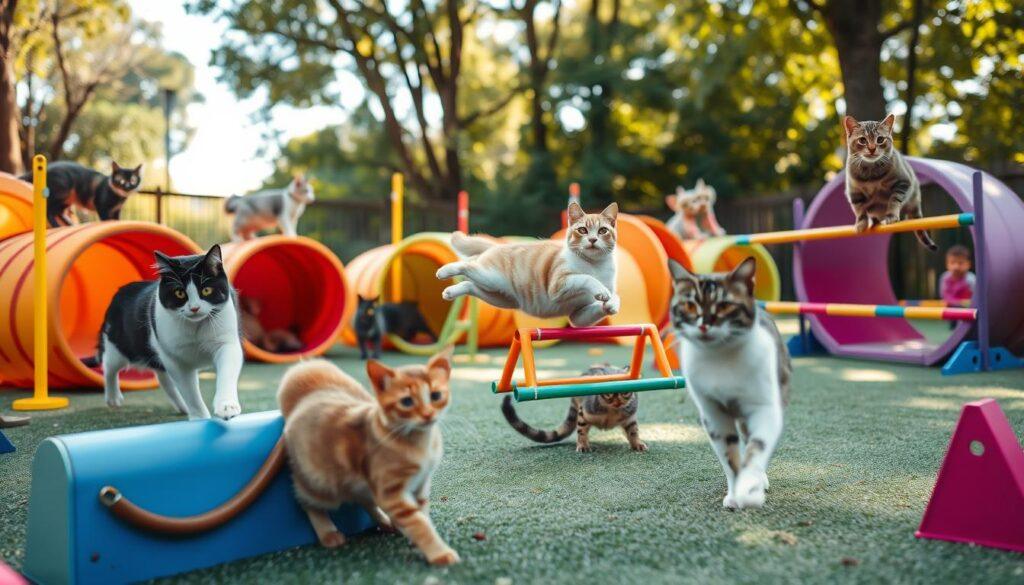Did you know cats have a shorter attention span than dogs? Dogs can focus for longer, but cats, especially kittens, can only stay focused for five to ten minutes1. This might make you think training cats is pointless. But, it’s actually quite possible!
Many people think cats can’t be trained, but experts disagree. With patience and persistence, cats can learn tricks and commands just like dogs. It might take a few sessions for them to get it, but it’s worth it2. Training a cat is different from training a dog, but it’s definitely doable and can be very rewarding for both the cat and the owner.
The secret to training a cat is to understand their unique nature and what they like. Cats love treats, praise, and extra kibble, and they do best with short, 10-minute training sessions. Training should happen once or twice a day23. By breaking training into small steps and being consistent, you can unlock your cat’s full potential and grow your bond with them.
Key Takeaways
- Cats have shorter attention spans than dogs, requiring shorter training sessions.
- With patience and persistence, cats can learn commands and tricks.
- Positive reinforcement methods work best for cat training.
- Short, consistent training sessions are key to success.
- Understanding a cat’s nature and preferences is crucial for effective training.
Tackling the Misconception: Can You Train a Cat?
Many people think cats can’t be trained because they are independent and have a different history with humans than dogs4. But, the truth is cats can learn a lot once we understand what motivates them4. Each cat is different, which can lead to misunderstandings about their ability to learn4.
Training cats often means fixing problems like litter box issues and furniture scratching4. To solve litter box problems, cats need multiple boxes, clean ones, and the right litter4. They also have their own preferences, so it’s important to pay attention to these4. For furniture scratching, cats need scratching posts, catnip, and understanding why they scratch in the first place4.

Cats usually need shorter training sessions than dogs5. They are more interested in immediate rewards than pleasing their owners5. They also have less energy than dogs5. Training cats often involves positive reinforcement and deterrents5.
To help your cat learn, adding probiotics to their diet can support their gut health5. B vitamins are also key for their energy, especially as they get older5. Some people use CBD oil to calm their cats during training, but always check with a vet first5.
Remember, every cat is unique, and their learning styles may differ. Be patient, consistent, and tailor your training approach to your cat’s individual needs.
If training your cat is tough, don’t worry. A professional cat trainer can help4. They offer valuable advice and methods to help you and your cat succeed, proving that cats are indeed trainable.
Understanding the Differences Between Cats and Dogs in Training
Cats and dogs train differently because of their natural behaviors. Cats, being solitary hunters, are more independent than dogs. Dogs, being pack animals, are easier to train because they follow a leader6.
Cats like treats or play as rewards, but they don’t want to please their owners like dogs do6. Dogs want to please and get approval, which helps in training6.

Natural Behaviors and Instincts
Knowing a cat’s body language is key for training6. Cats are more territorial than dogs, affecting their training6. Training a cat needs patience and short, positive sessions because of their short attention span6.
Dogs can handle longer training and various methods, including positive reinforcement6. They need more physical activities in their training, depending on their breed6.
Motivations and Rewards
Training success depends on rewards for cats and dogs. Dogs are motivated by praise and affection, while cats prefer food or play rewards.
| Motivations and Rewards | Cats | Dogs |
|---|---|---|
| Social rewards (praise, affection) | Less motivated | Highly motivated |
| Food rewards | Highly motivated | Motivated |
| Play rewards | Highly motivated | Motivated |
Understanding these differences helps in training cats and dogs better. Tailoring the training to their needs strengthens the bond with pets. Knowing the differences is key to a successful training experience.
As more people accept training for cats, the demand for cat trainers is expected to rise.7 Certified cat trainers ensure cats find homes that meet their needs. They know about feline personalities and temperaments, preventing cats from being abandoned at shelters7.
Puppies socialized with cats will be more comfortable around them as adults, just like kittens and dogs8.
Introducing pets properly is crucial. Use baby gates or screen doors for safe interactions. Short, frequent meetings help pets get used to each other8. Training dogs to be calm around cats involves rewarding calm behavior and supervising their interactions8.
How to Train a Cat: Basic Techniques
Training a cat might seem hard, but the right cat training techniques make it rewarding. Cats are more independent than dogs and need different reasons to learn9. So, training a cat needs patience and short, positive sessions9.
Positive Reinforcement
Positive reinforcement is key for cat training. Reward your cat with treats, praise, or affection when they do what you want. Cats like immediate rewards, like treats with a clicker10. Keep training short, about 10 minutes, and do it once or twice a day10.
Shaping Behavior
Shaping cat behavior means breaking down actions into small steps. For example, teach your cat to sit by rewarding them for leaning down. Keep raising the bar until they sit fully10. Cats learn slower than dogs, so be patient and teach bit by bit10.
Consistency and Patience
Training a cat needs patience and consistency. It takes at least three sessions for a cat to learn a command10. Daily training of about 30 minutes is key for effective training9. Remember, cats might take weeks to learn simple tricks like ‘sit’9.
Avoid Punishment
Never punish your cat for not doing what you want. Punishment can stress them out and make them less willing to learn10. Instead, focus on rewarding good behavior. If your cat doesn’t get it, ignore the behavior and try again later.
By using positive reinforcement, shaping behavior, being consistent, patient, and avoiding punishment, you can train your cat successfully.
Types of Cat Training
Many think cats can’t be trained, but with patience and the right methods, they can learn many things. Cats of any age can start training, showing that training works at any stage of their life11.
Training a cat takes more time and effort than a dog, needing many sessions to learn new tricks12. But, just a few minutes of training each day can make a big difference, showing that it’s not too much work11.
Litter Box Training
Teaching your cat to use the litter box is crucial. Kittens learn from their mothers, but older cats or kittens may need help. Be patient and reward them with treats and praise when they get it right.
Behavioral Training
Cat behavioral training helps fix bad habits and encourages good ones. Positive reinforcement works well to stop cats from scratching furniture11. Give them scratching posts and praise them when they use them.
Clicker Training
Clicker training for cats uses a device that makes a sound to mark good behavior. It’s very effective for cats, showing a great way to train them11. After the click, give a treat to reinforce the action. This method can teach cats many tricks and commands.
Leash Training
While less common than dog leash training, cat leash training is possible. It’s a great way to give your indoor cat outdoor adventures. Start with a harness indoors, then add the leash. Use treats and praise to encourage walking.
Using food as rewards works well for cats, as they don’t have the same need to please as dogs13. Use small rewards to avoid overfeeding, as obesity is common in cats13. Breaking treats into smaller pieces is a good strategy for training13.
| Training Type | Benefits |
|---|---|
| Litter Box Training | Ensures proper elimination habits |
| Behavioral Training | Corrects unwanted behaviors and reinforces positive ones |
| Clicker Training | Teaches tricks and commands effectively |
| Leash Training | Allows for safe outdoor exploration |
Training has incredible benefits for cats, such as building their confidence and preventing boredom, highlighting the positive impact on cat behavior and mental enrichment.
With commitment and dedication, cats can learn many things, just like dogs. They can walk on a leash, come when called, stay in place, and fetch toys12. Training a cat is similar to training a dog, showing that the methods are the same for different pets11.
What Supplements Aid in Cat Training?
Training a cat is more about changing their behavior than using supplements. Yet, some supplements can help by keeping them healthy and calm14. Fish oil has omega-3 fatty acids that might boost brain function and learning in cats14. Probiotics also support a healthy gut, making cats more focused and calm during training14.
Other supplements that might help in training cats include:
- B vitamins: Important for energy, especially in older cats14
- CBD oil: A calming supplement that can make cats more open to training14
- L-Theanine: A calming supplement that can reduce anxiety in some cats14
But, it’s crucial to use supplements carefully and only with a vet’s advice. Too many treats can harm a cat’s weight15. Here’s a table showing the benefits and cautions of common cat supplements:
| Supplement | Potential Benefits | Precautions |
|---|---|---|
| Fish Oil | Improves brain function and learning | May cause digestive upset in some cats |
| Probiotics | Maintains healthy gut flora for a relaxed cat | Consult a vet for proper dosage |
| B Vitamins | Maintains energy levels, especially in older cats | Excessive amounts can be harmful |
| CBD Oil | Calming effect, may improve receptiveness to training | Limited research on long-term effects in cats |
| L-Theanine | Reduces anxiety in some cats | May interact with certain medications |
While supplements can help, they shouldn’t be the only way to train a cat. Cats are naturally independent and need short, positive training sessions14. Being consistent, patient, and training in a clear, distraction-free area is key15.
“Cats respond well to immediate rewards like treats, catering to their preference for instant gratification.”14
In conclusion, a balanced approach is best. It combines proper training, a healthy diet, and the right use of supplements under a vet’s guidance. This way, you can train your cat successfully while keeping them healthy.
Can You Train a Cat Like a Dog?
Cats and dogs are different, but you can train cats like dogs with positive reinforcement. But, you need to adjust the training to fit cats’ unique nature. Knowing the differences between cat and dog helps tailor training methods for their life stages.
For cat training vs dog training, it takes at least three sessions for a cat to learn a command. Keep training sessions short, about 10 minutes, and do them once or twice a day. Focus on one trick at a time until they get it right16.
Studying cat behavior is newer than studying dogs, with only 15 years of research. Cats were bred for guarding and herding, unlike dogs. This affects how we train them17.
Despite these differences, feline learning can be achieved with positive reinforcement. Cats love treats as rewards during training. Avoid scolding or punishing them, as it stresses them out1617.
Start training cats early, as they learn better when young. But, older cats can also learn new tricks if they’re healthy enough1617.
“Cats are very independent. They’re very stubborn. But they can be trained.” – Jackson Galaxy, Cat Behavior Expert
Some examples of cat training success include:
| Training Type | Description |
|---|---|
| Trick Training | Teaching cats to perform tricks such as sitting and following a target |
| Name Recognition | Teaching cats to recognize and respond to their name when called |
| Husbandry Training | Making caring for cats easier, such as teaching them to be comfortable with carriers or receiving treatments |
Training a cat can be rewarding. Understand the differences in training, find the right motivators, and be patient and consistent. Just train them in a way that works for them!
Conclusion
Training your cat is a rewarding journey that strengthens your bond and shows off their talents. Cats may seem independent and less likely to follow commands than dogs18. But, with patience, consistency, and the right rewards, they can learn. Positive reinforcement, like treats or play, works best for cats because they love instant rewards18.
Short, positive training sessions and understanding your cat’s natural behaviors are crucial. This approach leads to successful cat training.
There are many types of cat training, like litter box training and leash training, to meet different needs18. A study showed that 79% of cats learned to touch a target, 60% learned to spin, and 31% learned to high-five with clicker training19. Some breeds, like Maine Coons and Turkish Angoras, might be more eager to learn20.
Supplements like fish oil and CBD oil can help with training, but always get vet advice first18.
Starting your cat training journey requires patience and consistency. Celebrate every small win. With the right effort, you can teach your cat amazing tricks. Share your success to inspire others to train their cats too. Cat training opens up a world of possibilities – take on the challenge and watch your bond grow!
FAQ
Can cats really be trained like dogs?
What are the most effective techniques for training a cat?
Are there any supplements that can help with cat training?
What are the different types of cat training?
How long does it typically take to train a cat?
Source Links
- Can a Kitten Be Trained Like a Dog? | Comfort Zone – https://www.comfortzone.com/behavior-blog/cat-behavior/can-a-kitten-be-trained-like-a-dog
- Is it Possible to Train a Cat Like a Dog? – https://petwellbeing.com/blogs/news/is-it-possible-to-train-a-cat-like-a-dog?srsltid=AfmBOoo9qhfMDKGHE0k9eQI0ZByJefxWzU-nt5XDVHxRMlXiPHfmTPd-
- Can You Train Cats Like Dogs? Let’s Find Out! – https://drruthroberts.com/blogs/pet-blog/can-cats-be-trained-like-dogs-guide?srsltid=AfmBOopIBSrJo_drIusiZeWII6km4MpXADc2H8dwnNthfg8d_PORgf_T
- Training Cats? Yes Really! (Part 1) – https://www.kongcompany.com/training-cats-yes-really/
- Can You Train Cats Like Dogs? Let’s Find Out! – https://drruthroberts.com/blogs/pet-blog/can-cats-be-trained-like-dogs-guide?srsltid=AfmBOoreq2NQhmq1iJqqPfuShY0660G2wWsLAS4x3a-0_2yqOH2VYF_n
- Can You Train Cats Like Dogs? Let’s Find Out! – https://drruthroberts.com/blogs/pet-blog/can-cats-be-trained-like-dogs-guide?srsltid=AfmBOopH4Hj4pckpPbwqYjmSumbLox4mes5X_Xy82ekAiknuEYqAdzI9
- Can Cats Be Trained? – Animal Behavior College – https://www.animalbehaviorcollege.com/blog/pet-training/can-cats-be-trained/
- No title found – https://www.akc.org/expert-advice/training/teaching-dogs-cats-live-together/
- Can You Train Cats Like Dogs? Let’s Find Out! – https://drruthroberts.com/blogs/pet-blog/can-cats-be-trained-like-dogs-guide?srsltid=AfmBOoqiPUFN5B2KMqS1cfhvBsR-5HrFM7jNZ_AbTGLLqgUDF9ieFYI2
- Is it Possible to Train a Cat Like a Dog? – https://petwellbeing.com/blogs/news/is-it-possible-to-train-a-cat-like-a-dog?srsltid=AfmBOoprzhLaODsi2sNxcXvrEhBZBUxkaOOhkJB01DBaT8AIN3voUiRs
- Can You Train Cats? – https://www.zoetispetcare.com/blog/article/can-train-cats
- Can Cats Be Trained Like Dogs? Vet-Approved Tips & Tricks – Catster – https://www.catster.com/cat-behavior/can-cats-be-trained-like-dogs/
- How to train a cat | BPS – https://www.bps.org.uk/psychologist/how-train-cat
- Can You Train Cats Like Dogs? Let’s Find Out! – https://drruthroberts.com/blogs/pet-blog/can-cats-be-trained-like-dogs-guide?srsltid=AfmBOorS9Etv3NtXiRv1jYBIIGWKiDCnn1dmf_oWvxYms7Gkth3lnfUa
- Can You Train a Cat? | Benefits, Do’s, and Don’ts of Cat Training – https://yourpetandyou.elanco.com/us/behavior/can-you-train-a-cat
- Is it Possible to Train a Cat Like a Dog? – https://petwellbeing.com/blogs/news/is-it-possible-to-train-a-cat-like-a-dog?srsltid=AfmBOorsJzUak-2SD3DITTHwqVdNR9FpsvoFuJdwTPoYwpBD-zTNRY5A
- Can I train my cat like a dog? We ask an expert – https://www.theguardian.com/lifeandstyle/2022/dec/16/can-i-train-my-cat-like-a-dog-we-ask-an-expert
- Can You Train Cats Like Dogs? Let’s Find Out! – https://drruthroberts.com/blogs/pet-blog/can-cats-be-trained-like-dogs-guide?srsltid=AfmBOor9QCExPFI7f8Lvnn8J1-UwtfTYCBpaCwCEmHwvmW7Gqvt6i6tY
- Assessment of Clicker Training for Shelter Cats – https://pmc.ncbi.nlm.nih.gov/articles/PMC5664032/
- My Cat Acts Like a Dog – Is This Normal? – Auburndale Veterinary Clinic – https://auburndalevets.com/blog/my-cat-acts-like-a-dog/

